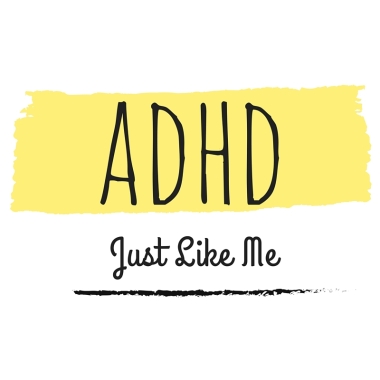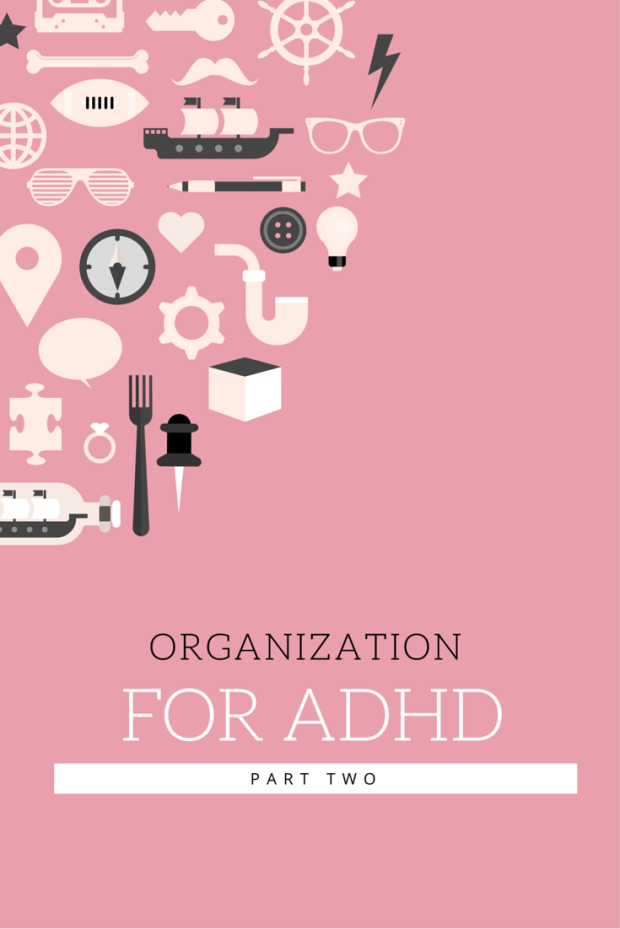
An Organized Bedroom Environment for PEOPLE WITH ADHD
IN THIS BLOG POST I’ll talk specifically about my main environment I organized to be ADHD-friendly: my bedroom. I say this is my “main environment” because this is where I spend most of my time when I’m at home. I’m going to be honest with you—I’m just getting out of college so I moved back in with my parents until I save up enough money to live on my own. Perhaps one day I’ll write a blog post about my journey of organizing my apartment to be ADHD-friendly. But for now, let’s focus on how I organized my current bedroom to be ADHD-friendly.
Notes On Feng Shui
BEFORE WE CONTINUE with my organizational process that follows up from my last blog post (Organization for ADHD: Part One), let’s discuss Feng Shui.
I am a big advocate for Feng Shui. Why? Because I’ve seen its positive effects. Yep, that’s right! I lived at Michigan State University for four and a half years. Three of those years I live in a space that was not “Feng Shui-ed.” And then I spent one and a half years in a space that was “Feng Shui-ed.” During the non-Feng-Shui years, I had a very difficult time in college. However, during the Feng Shui years, my time in college was so much better, and much more manageable. I was happier, more energized, positive, and best of of all—I felt in control. It seriously felt like a night and day difference.
I WANT TO TALK ABOUT FENG SHUI as it relates to ADHD organization because I honestly believe it creates a more positive, stress-free environment for those afflicted with ADHD.
I don’t want to bore you with an incredibly long list of all the resources I referenced to Feng Shui my living spaces. Instead I’ll provide you with a link to my Pinterest board, which focuses on Feng Shui.
MY OWN FENG SHUI TIPS are pretty basic. They are definitely covered in the proverbial “Feng Shui 101.” However, I do want to warn you—there are things that are no-no’s in Feng Shui that I choose not to pay attention to. But here’s the thing, because I live with my parent’s, my room has to store all of my things (clothes, items for hobbies, books, etc.). And because of that, I’ve had to make some Feng Shui sacrifices in order to achieve a desirable living space. For instance, storing things under your bed is a Feng Shui no-no. However, I put my bed on risers for the sole purpose of creating extra storage space for my arts and crafts supplies. And some Feng Shui resources say you shouldn’t put your books in your bedroom—or that you should only keep the ones you’re currently reading in there. However, I have to keep my books in my room because I do not have the ability to store them elsewhere. So my suggestion is to take Feng Shui tips with a grain of salt, and adapt them to your lifestyle.
Here are the Feng Shui tips/rules I do follow:
Your Bed:
- The bed should be in direct view of the door, however it should also be as far from the door as possible. This gives you a sense of safety and easiness while resting.
- The bed should have a sturdy headboard to create a sense of stability. However, if you don’t have a headboard you can position it against a wall.
- Make sure your bed is a good height, don’t put the mattress, box spring, or frame directly on the floor. The frame of your bed should have legs. And if you desire you can use risers to increase it’s height. Having your bed off the floor creates a sense of flow and control over the bed, and the space itself.
Electronics:
- Electronics in your bed room should be limited, if not non-existent. If you absolutely must have them in your room cover them up when not in use. For instance, I have cover that I made for my sewing machine. And I just cover my cellphone up with a washcloth when I go to sleep. Doing things like this makes sure that your peace is not disturbed or distracted when you are trying to rest, decompress, and rejuvenate yourself.
Lighting:
- Use natural lighting as much as possible during the day. That means opening your curtains and blinds.
- When you must use artificial lighting, opt for soft lighting. I personally need a lot of light in a room to focus clearly, and not get sleepy again in the morning. So I have as many lamps in my room as possible.
- Hanging a crystal by the window can make a space feel more open and positive. Plus it looks so pretty when the sun hits it and casts little rainbows all over your room.
Visuals:
- Place inspiring art and wall decor in your bedroom. This will create positivity and confidence in your life.
- Use the Feng Shui colors for each part of your room. That is, your room is divided up into elements (i.e., wood, metal, earth, water, and fire). Each area that is represented by one of these elements has specific colors associated with it. Try to incorporate those colors into your decorating. You can find more information about the elements and colors on my Feng Shui Pinterest board.
HERE’S HOW I FENG SHUI-ED MY ROOM. I measured my room’s dimensions, and the dimensions of all my furniture. I then headed on over to floorplanner.com to make a digital floor plan of my room. I did this because I wanted to experiment with different room layouts without having to actually move furniture. You can do the same thing with graph paper and a writing utensil. Just draw the dimensions of your room, making sure to include any little quirks (e.g. having five corners in a room instead of four—like my room!). And then draw boxes in the dimensions of your furniture. Or if you don’t feel like doing any of that you can just move your furniture around as many times as you want until you get your preferred layout. Here’s an image of my floor plan I made on floorplanner.com:

At the front left of my room is my sewing table. Along the left side are all the boxes where I keep my craft, sewing, and knitting supplies. Along the back wall on the left side and above, are my bookshelf and a ledge that runs along the entire back wall, where I store the rest of my books and other knick-knacks. Along the back wall to the right is my night stand and a crate on the floor where I put recycling. My closet is inset along the right wall. And there’s a screw-in coat rack along the front right side wall. Under my bed I store more craft, sewing, and knitting supplies. Finally, within my closet I store my clothes, shoes, accessories (i.e., bags, belts and hats), and camping gear.
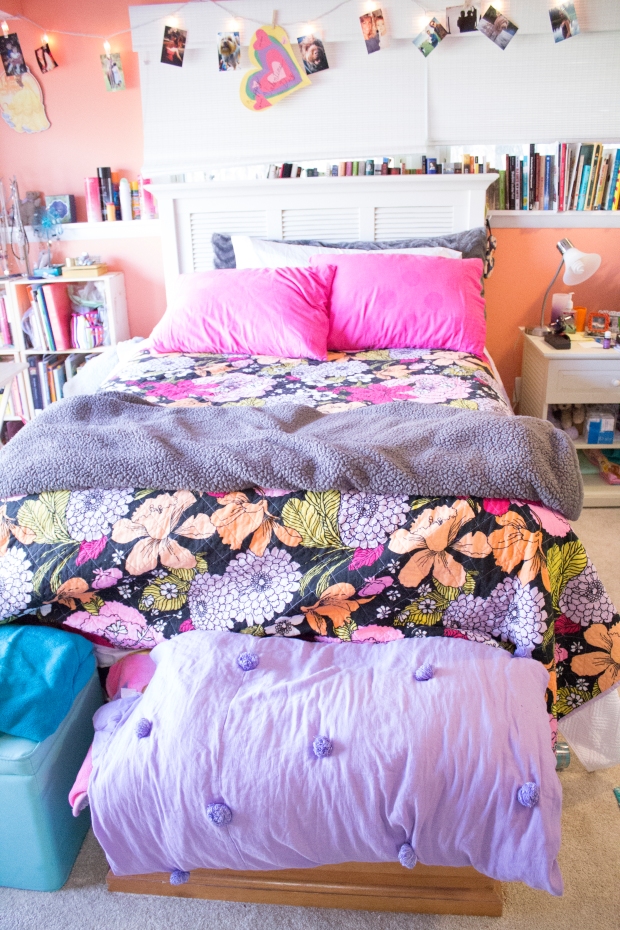
My bed, which is placed in the center of the room so I can walk all the way around it. It makes it much easier to make my bed in the morning, and creates flow throughout my room.

My sewing area has all my sewing equipment and books that I use on a regular basis. I also sometimes store my current knitting project here too.


I keep my inspirational visuals in this corner of my room. They include Wonder Woman and Disney Princess Belle (two feminists lol), I also store my jewelry here, out in the open, so it’s easily accessible.
So You’ve Feng Shui-ed and purged . . .
NOW that you’ve purged your room (more on that here) and feng shui-ed your room, it’s time to divide your room into little areas. Think of your room like a government building, every department has their own area. Apply that thinking to your room, every item is grouped together by the task or activity it serves. For instance, in my room, I have different areas for clothes, books, crafts, sewing, knitting, and laundry. And within those areas I have sub-areas. In my clothes area, I have my closet divided up by clothing type. Leggings go on one shelf, blouses hang on the rack in a marked space, and tights get their own plastic milk crate. I did this for my craft area and my book area too. Most importantly, I LABELED these sub-areas.
Labeling With Washi Tape
In my closet, drawers and shelves are labeled with Washi tape and permanent marker. I label the tape and place it on the container with the items that occupy its interior.
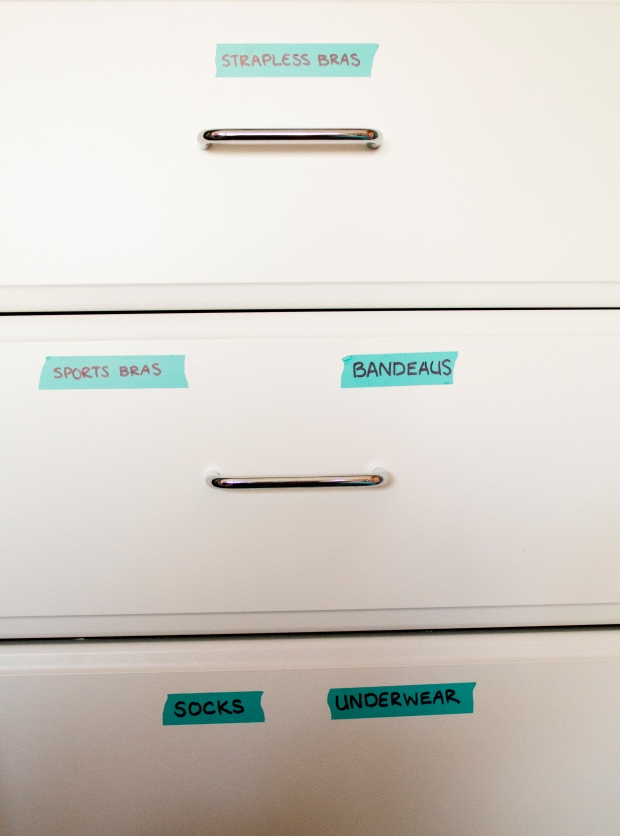
Because I don’t Have a ton of drawer space, I double up some drawers and made a cardboard divider to separate the different items.
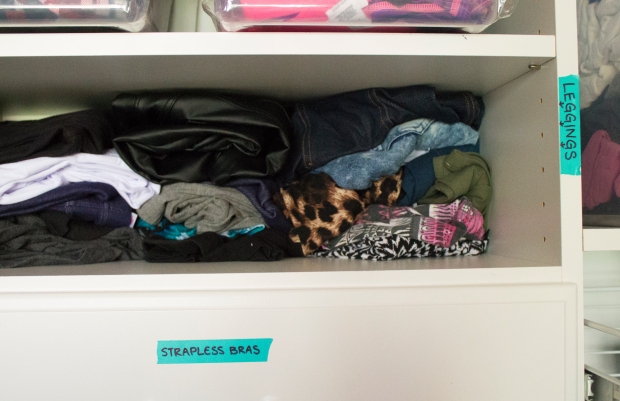
organizing shelving space with plastic bins and tubs
I have Sterilite plastic tubs labeled with erasable white board marker indicating what’s inside (e.g. tank tops, t-shirts, pants, shorts, work-out attire, etc.). You can find some of the tubs I used here. But remember I measured my shelving and found specific tubs that fit those dimensions. So you may have to buy different tubs in order to fit your closet space.
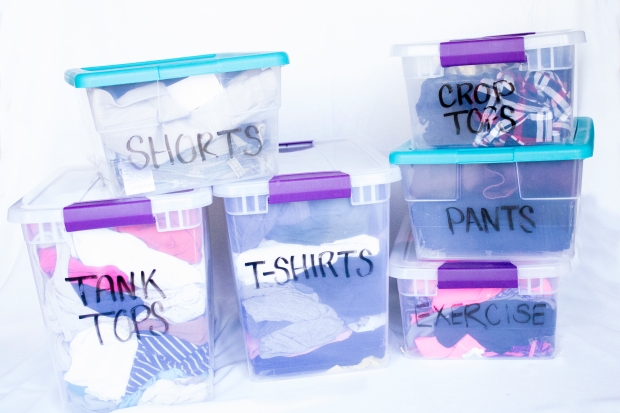
I choose NOT to fold my clothes? Why? Because I have a lot of them (and clothing is one of my passions so I have a hard time being a minimalist when it comes to that). Plus it makes the process of putting clothing back in it’s place a whole lot easier. If something is too wrinkled to wear I just use Downy Wrinkle Release Spray and toss it in the dryer for a few minutes with a dryer sheet.
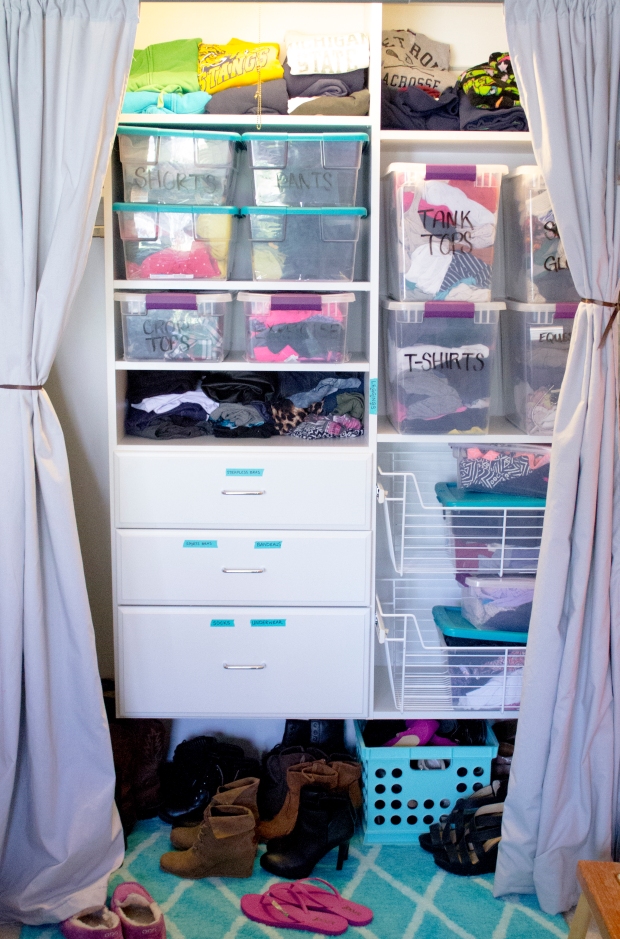
I keep the shoes I wear most often outside my closet (i.e. my slippers and flip flops) and then I line up the rest of my shoes like little soldiers, grouping together type and frequency of use. Because I have so many heels for work I just went ahead and stuck them in a plastic milk crate. Probably a little harder to get to my shoes easily, but I love my shoes too much to get rid of them.
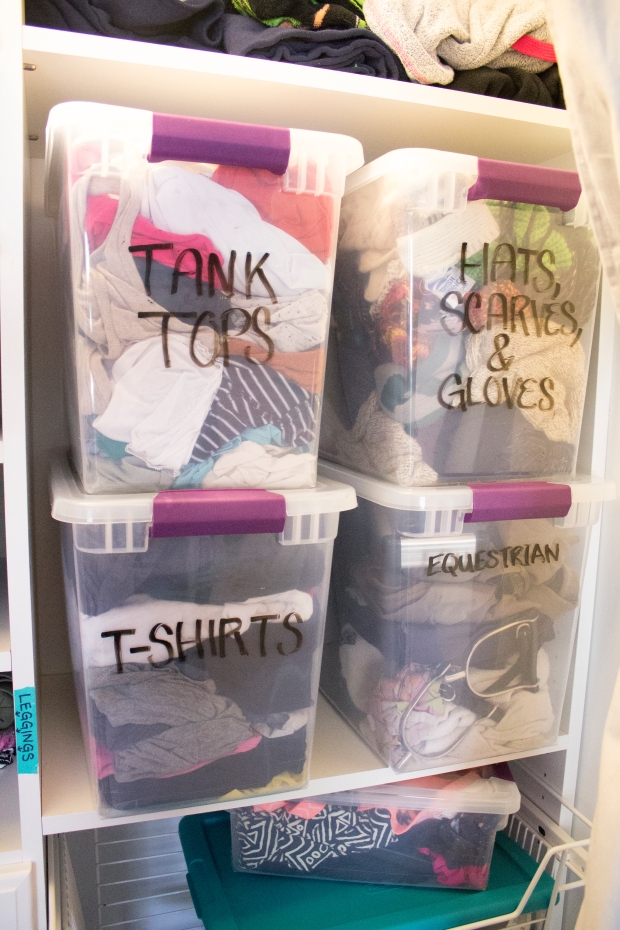
I label all my bins with erasable whiteboard marker. And because I do that, I can change the labels based on the season. For instance, when summer rolls around I can swap out my “Hats, Scarves, & Gloves” label for something else that I’ll put in that bin.
The author of Organizing Solutions for People with ADHD, recommends that you use these types of plastic stackable storage bins (seen below). However, when I was buying for organizing my closet space, I couldn’t find these anywhere . . . not even on amazon. I believe that they are more popular now, so if you so choose, these can be an alternative to my Sterilite plastic storage tubs. These bins that the author suggests are a little easier to deal with because they don’t have tops on them. So you can just toss your clothes back in the container and not having to worry about putting a lid back on.
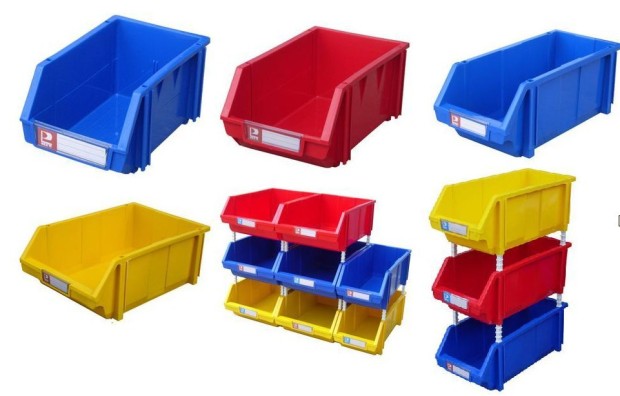
organizing rack space with closet dividers
The racks in my closet have plastic closet dividers with names as to what kinds of outfits the clothes are for (e.g., work, casual, evening, etc.). I got my closet dividers off of Amazon.com, you can find ones like them here and here. And here’s a DIY tutorial on how to make your own closet dividers!
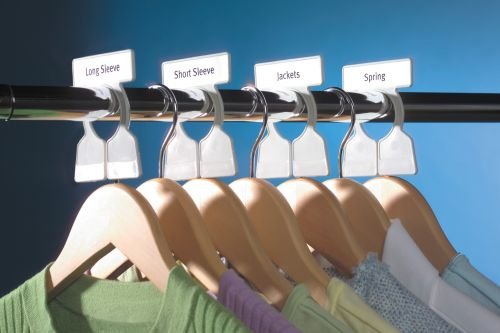
ADHD Organization Results
ORGANIZING FOR MY ADHD has made my life so much easier. And I am not exaggerating, in any way. I can always can find what I’m looking for. Clean up is a snap. And the stress in my life has been significantly reduced. Bottom line, the organization system I have instilled in my life, just for my bedroom, makes me much happier.
When I’m in my room now, my mind is clear and I’m free to go about my tasks with little to no difficulty because it is so much easier to focus. When my room was messy and disorganized it required so much energy and focus to remember where things were and then go and look for them. I am so, so, so happy that I found this organizational system because it has completely revolutionized my life.
NOW IT’S YOUR TURN! Try out this or a similar organizational system in your bedroom, give it a month or two to get use to it. And then evaluate the results. You may have to adjust how you do things in order to fit your lifestyle, but that’s okay! Much of the process of managing ADHD has to deal with trial and error. Just don’t give up!
Are you going to try out this organizational system for your bedroom? What ideas do you have about how you can adjust and, or, improve on the system I’ve presented to you? Share your input in the comment section below!
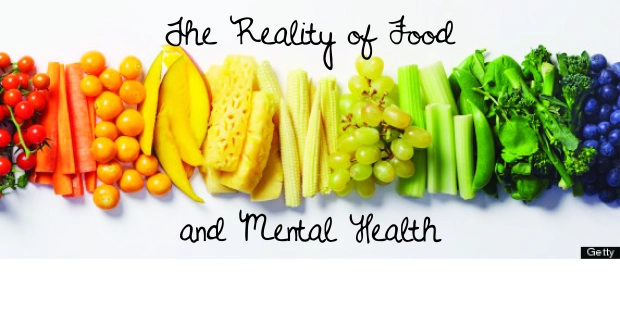 ***NOTE: THIS POST IS MAINLY ABOUT BIPOLAR DISORDER. HOWEVER, THE CONCEPTS CAN ALSO RELATE TO ADHD AND OTHER MENTAL AND, OR BEHAVIORAL DISORDERS. SINCE DIET, EXERCISE, AND PROPER HABITS ARE TIED TO PROPER MANAGEMENT OF THESE TYPES OF CONDITIONS.***
***NOTE: THIS POST IS MAINLY ABOUT BIPOLAR DISORDER. HOWEVER, THE CONCEPTS CAN ALSO RELATE TO ADHD AND OTHER MENTAL AND, OR BEHAVIORAL DISORDERS. SINCE DIET, EXERCISE, AND PROPER HABITS ARE TIED TO PROPER MANAGEMENT OF THESE TYPES OF CONDITIONS.***